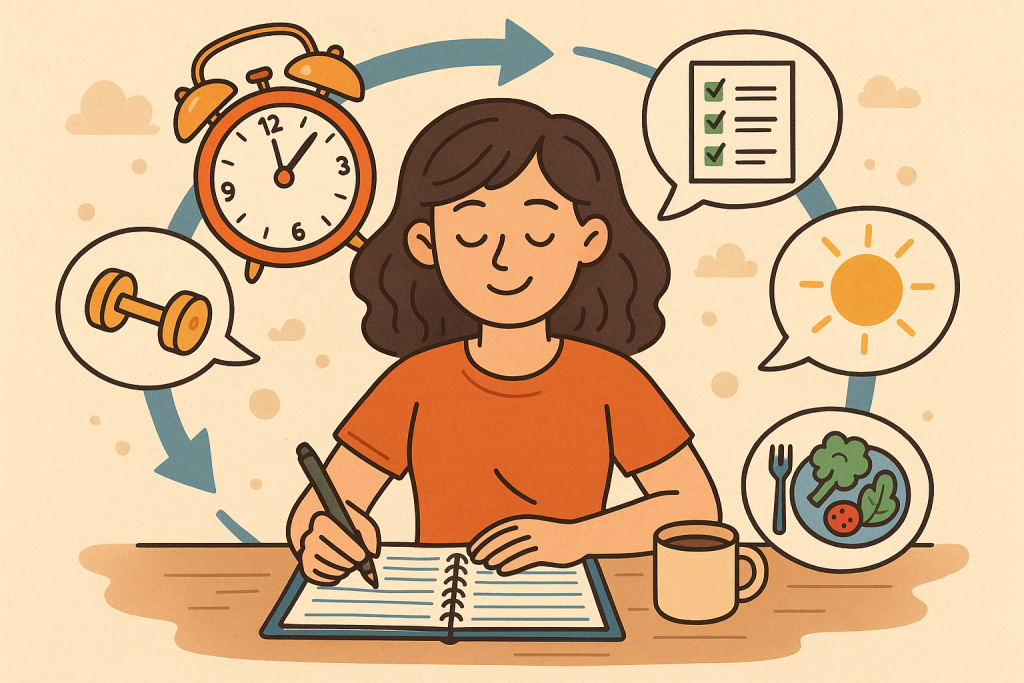Ever thought about how to build a routine without feeling overwhelmed? You’re not alone. Today, millions are seeking a balance between structure and flexibility—and there’s a smart way to get there. This guide dives into research-backed, actionable strategies to help you design a daily routine that sticks—without stress.

Why Building a Routine Matters
Routines do more than add structure—they improve mental health, reduce decision fatigue, and boost productivity. Studies from Northwestern emphasize starting small, making plans, and reframing routines as habit-building rather than lifestyle overhauls . Meanwhile, Verywell Mind explains that routines create predictability and reduce anxiety in stressful times.
Trend Spotlight: Habit Stacking
One of the hottest emerging trends is habit stacking — attaching a new habit to an existing one to make it automatic. Cleveland Clinic notes habit stacking rewires your brain by leveraging strong, existing routines. InsightTrends calls it “Integrated Habit Formation,” aligning perfectly with 2025’s digital well-being culture. This trend makes it surprisingly easy to build a routine without feeling overwhelmed.
Step-by-Step Guide: Build a Routine Without Feeling Overwhelmed
1. Start with One Small Change
Take just one simple step — don’t revamp your entire day at once. According to Mental Health America, small changes stick, while drastic shifts tend to fail.
Action:
- Choose one keystone behavior like drinking water after waking up.
- Make it non-negotiable.
2. Use Habit Stacking
Slot your new habit right after something you already do, like:
- “After I brush teeth, I’ll stretch for 1 minute.”
- “After brewing coffee, I’ll journal three bullet points.”
Cleveland Clinic supports this: your brain uses the existing habit as a cue for the new action.
3. Build Tiered Routines
Reddit users share success by tiering routines:
“Define 3 levels of morning routine… Level 1 is that first habit, without fail… All that matters is YOU NEVER MISS 2 DAYS OF LEVEL 1 IN A ROW.”
Action:
- Create Level 1 (must-do), Level 2 (nice-to-have), Level 3 (full routine).
- Track progress—use dots or shading to mark each level.
4. Be Flexible and Kind to Yourself
Rigid schedules cause burnout. Verywell Mind recommends a flexible structure: set wake/sleep, meals, and exercise windows—not strict times—and be compassionate when things shift .
Action:
- Aim for consistency, not perfection.
- Adjust according to your energy levels and commitments.
5. Scale Gradually
Once Level 1 feels automatic, add another habit. Public Health advice: add no more than one habit at a time to reduce overwhelm and stay consistent.
Action:
- Check if Level 1 is sticky (80% consistency for two weeks).
- Then stack Level 2: e.g., five minutes of reading after coffee.
Pro Tips to Sustain Your Routine
- Use reminders – set phone notifications or post sticky notes near your anchor routines.
- Celebrate small wins – rewarding progress strengthens motivation.
- Track visually – use paper calendars or apps to mark Level 1/2/3 completions.
- Batch similar habits – group small tasks like mindfulness techniques between daily habits. Entrepreneur endorses this, suggesting pairing a new action like meditation with routine activities .
Sample Routine Outline
| Routine Tier | When | What to Do |
|---|---|---|
| Level 1 | Upon waking after brushing your teeth | Drink a glass of water (Cue → Action) |
| Level 2 | Right after water | Stretch for 2 minutes + deep breathing (stacked) |
| Level 3 | After stretching | Journal 2–3 gratitude points; plan for the day |
This approach helps you build a routine without feeling overwhelmed—slow, steady, and stress-free.
Why This Works (Science & Psychology Explained)
- Neuroplasticity: Habit stacking links new neural pathways to existing ones, easing habit formation.
- Cue-Routine-Reward Loop: According to the Daily Telegraph, strong cues followed by routines with instant rewards reinforce habits effectively.
- Reduced Decision Fatigue: By anchoring small actions, your brain doesn’t have to re-decide—they become automatic, saving energy and mental bandwidth.
Troubleshooting Common Challenges
- Missed Days?
Just Level 1: follow Reddit’s advice — never miss Level 1 two days in a row . - Too Rigid?
Verywell Mind encourages flexible structures over rigid blocks: built-in buffer zones and choice-based habit windows . - No Progress?
Confirm habit is truly “stacked.” Use the formula: “After [old habit], I will [new habit].” Without clear triggers, routines stall retail-insider.com.
Final Thoughts
If you want to build a routine without feeling overwhelmed, lean on habit stacking, begin with one small change, embrace flexibility, and scale gradually. This isn’t about perfection—it’s about consistency. One small, sustainable habit can lead to powerful, lasting growth.
References
Mental Health America. Creating Healthy Routines. (2025). Includes practical advice on planning ahead, swapping unhealthy behaviors, and celebrating small wins to reduce overwhelm.
https://mhanational.org/
Psychology Today. “Routine Reset: Daily Habits for Good Mental Health.” (December 2023). Emphasizes why starting small, setting boundaries, and adjusting routines proactively prevent burnout.
https://www.psychologytoday.com
Verywell Mind. “The Importance of Keeping a Routine During Stressful Times.” (May 2025). Explains how consistent wake/sleep schedules, meals, and activities improve stress resilience.
https://www.verywellmind.com






